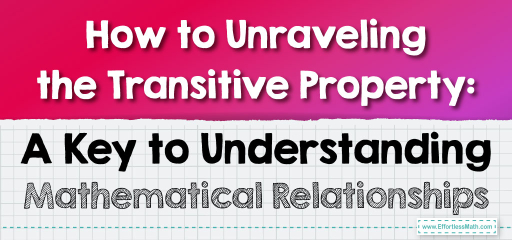How to Unraveling the Transitive Property: A Key to Understanding Mathematical Relationships
The transitive property is a fundamental concept in mathematics and logic. It states that if a relation holds between a first and a second element, and also between the second and a third element, then it must hold between the first and the third element as well. This property is crucial in various mathematical proofs and logical arguments.

Understanding the Transitive Property: A Step-by-Step Guide
Step 1: Definition of Transitive Property
- In the context of equality, the transitive property states that if \(a=b\) and \(b=c\), then \(a=c\).
- In terms of inequality, if \(a<b\) and \(b<c\), then \(a<c\).
Step 2: Identifying the Elements
- The transitive property involves three elements. In the inequality example, these are \(x\), \(y\), and \(z\).
Step 3: Understanding the Relation
- The relation (like \(=\) or \(<\)) must be consistent among all elements. For instance, in \(x<y\) and \(y<z\), the relation is \(<\) (less than).
Step 4: Applying the Property
- If the first relation is \(x<y\) and the second relation is \(y<z\), then the transitive property allows us to infer a third relation, \(x<z\), without directly comparing \(x\) and \(z\).
Step 5: Applying the Transitive Property to Inequalities
Let’s delve into your specific condition: If \(x<y\) and \(y<z\), then \(x<z\).
- First Condition (\(x<y\)): This states that \(x\) is less than \(y\).
- Second Condition (\(y<z\)): This indicates that \(y\) is less than \(z\).
- Applying Transitivity:
- Here, we have two inequalities with a common element, \(y\).
- Since \(x\) is less than \(y\) and \(y\) is less than \(z\), it logically follows that \(x\) must be less than \(z\).
- This inference is a direct application of the transitive property to inequalities.
Final Word
In summary, the transitive property is a logical tool that simplifies mathematical reasoning by allowing us to infer relationships between elements without direct comparison. In the context of inequalities, it helps establish order and hierarchy, facilitating problem-solving and proof construction in mathematics. Understanding and applying this property is fundamental to mathematical literacy and logical thinking.
Examples:
Example 1:
If \(a<b\) and \(b<c\), is it true that \(a<c\)? Assume \(a\), \(b\), and \(c\) are real numbers.
Solution:
- Given: \(a<b\) and \(b<c\).
- By the transitive property of inequalities, if \(a\) is less than \(b\), and \(b\) is less than \(c\), then \(a\) must be less than \(c\).
- Therefore, it is true that \(a<c\).
Example 2:
Consider three algebraic expressions: \(x+5=y−3\), \(y−3=z+2\). Can we say \(x+5=z+2\)?
Solution:
- Given: \(x+5=y−3\) and \(y−3=z+2\).
- By the transitive property of equality, if \(x+5\) equals \(y−3\), and \(y−3\) equals \(z+2\), then \(x+5\) must equal \(z+2\).
- Therefore, it is true that \(x+5=z+2\).
Related to This Article
More math articles
- Algebra Puzzle – Challenge 53
- Full-Length AFOQT Math Practice Test
- How to Unravel the Vectorial Realm: A Comprehensive Guide to Vector Applications in Mathematics”
- What are the four Branches of Mathematics?
- How to Find Complex Roots of the Quadratic Equation?
- The Great Math Tour: Exploring the World of Circle Graphs
- Top 10 ASTB Math Practice Questions
- Full-Length TASC Math Practice Test-Answers and Explanations
- 7th Grade SBAC Math Worksheets: FREE & Printable
- 8th Grade NDSA Math Worksheets: FREE & Printable






What people say about "How to Unraveling the Transitive Property: A Key to Understanding Mathematical Relationships - Effortless Math: We Help Students Learn to LOVE Mathematics"?
No one replied yet.